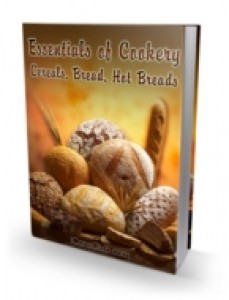 License Type: Private Label Rights
License Type: Private Label Rights  File Size: 17,383 KB
File Size: 17,383 KB File Type: ZIP
File Type: ZIP
 SKU: 3341
SKU: 3341  Shipping: Online Download
Shipping: Online Download
Ebook Sample Content Preview:
Cooking with dry heat includes broiling, pan broiling, roasting, and baking; but, whichever of these processes is used, the principle is practically the same. In these processes the food is cooked by being exposed to the source of heat or by being placed in a closed oven and subjected to heated air. When dry heat is applied, the food to be cooked is heated to a much greater temperature than when moist heat is used.
BROILING.-The cooking process known as broiling consists in exposing directly to the source of heat the food that is to be cooked; that is, in cooking it over or before a clear bed of coals or a gas flame. The aim in broiling is to retain the juices of food and develop flavor. As it is a quick method, foods that are not tender, as, for example, tough meats, should not be broiled, because broiling does not help to render their fibers more tender. In applying this cooking process, which is particularly suitable for tender portions of meat and for young fowl, the food should be exposed to intense heat at first in order to sear all surfaces quickly and thus retain the juices. At the beginning of the cooking, the article that is being broiled should be turned often; then, as soon as the outside is browned, the heat should be reduced if possible, as with a gas stove, and the article allowed to cook until done. If the broiling is done over coals, it is necessary to continue the turning during the entire process. While broiling produces an especially good flavor in the foods to which it is applied, provided they are not tough, it is not the most economical way of cooking.
PAN BROILING.-Pan broiling is an adaptation of the broiling method. It consists in cooking food in a sissing-hot pan on top of the stove without the use of fat. In this process the surfaces of the steak, chop, or whatever the food may be, are quickly seared, after which the article is turned frequently and cooked more slowly until done. The object of pan broiling is the same as that of broiling, and it is resorted to, as a rule, when the fire is not in the right condition for broiling.
ROASTING.-Originally, the term to roast meant to cook before a fire, because, before the time of stoves, practically all food was cooked in the fireplace. Food that was to be roasted was placed before the fire in a device that reflected heat, this device being open on the side toward the fire and closed on that toward the room. The roast was suspended in this device, slowly turned, and thus cooked by radiant heat--that is, heat given off in the form of direct rays--the principle being the same as that of broiling, but the application different. Nowadays, the term roasting is almost universally applied to the action of both hot air and radiant heat. However, much of what is called roasting is in reality baking. Foods cooked in the oven of an ordinary coal or gas range are really baked, although they are said to be roasted, and a covered roasting pan is a misnomer. Food must be exposed to the air in the process of cooking if it is to be roasted in the true sense.
It may be well to note that successful roasting or broiling depends more on the shape of the article to be roasted or broiled than on its weight. For this reason, thick, compact cuts of meat are usually selected for roasting and thin cuts for broiling. Good results also depend very much on the pan selected for the roasting process. One of the great aims in cooking should be to save or conserve all the food possible; that is, if by one process less waste in cooking results, it should be chosen rather than one that will result in loss at the end of the cooking process.
- File Size:17,383 KB
- License: Private Label Rights
- Category:Ebooks
- Tags:2010 Ebooks Private Label Rights








